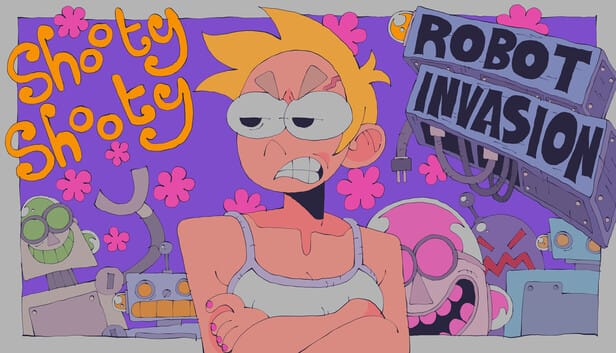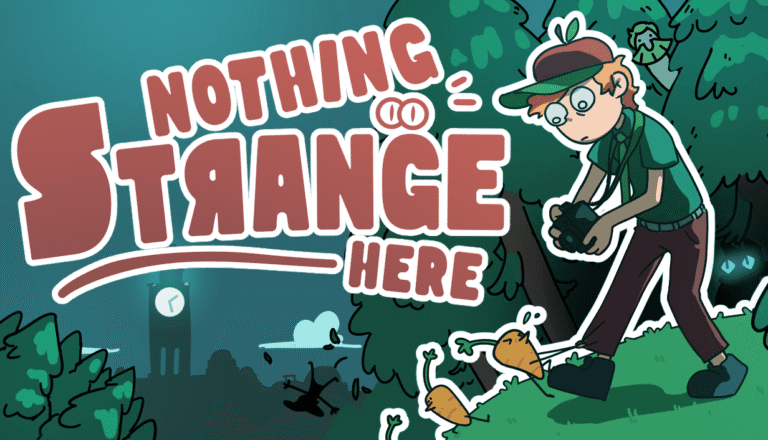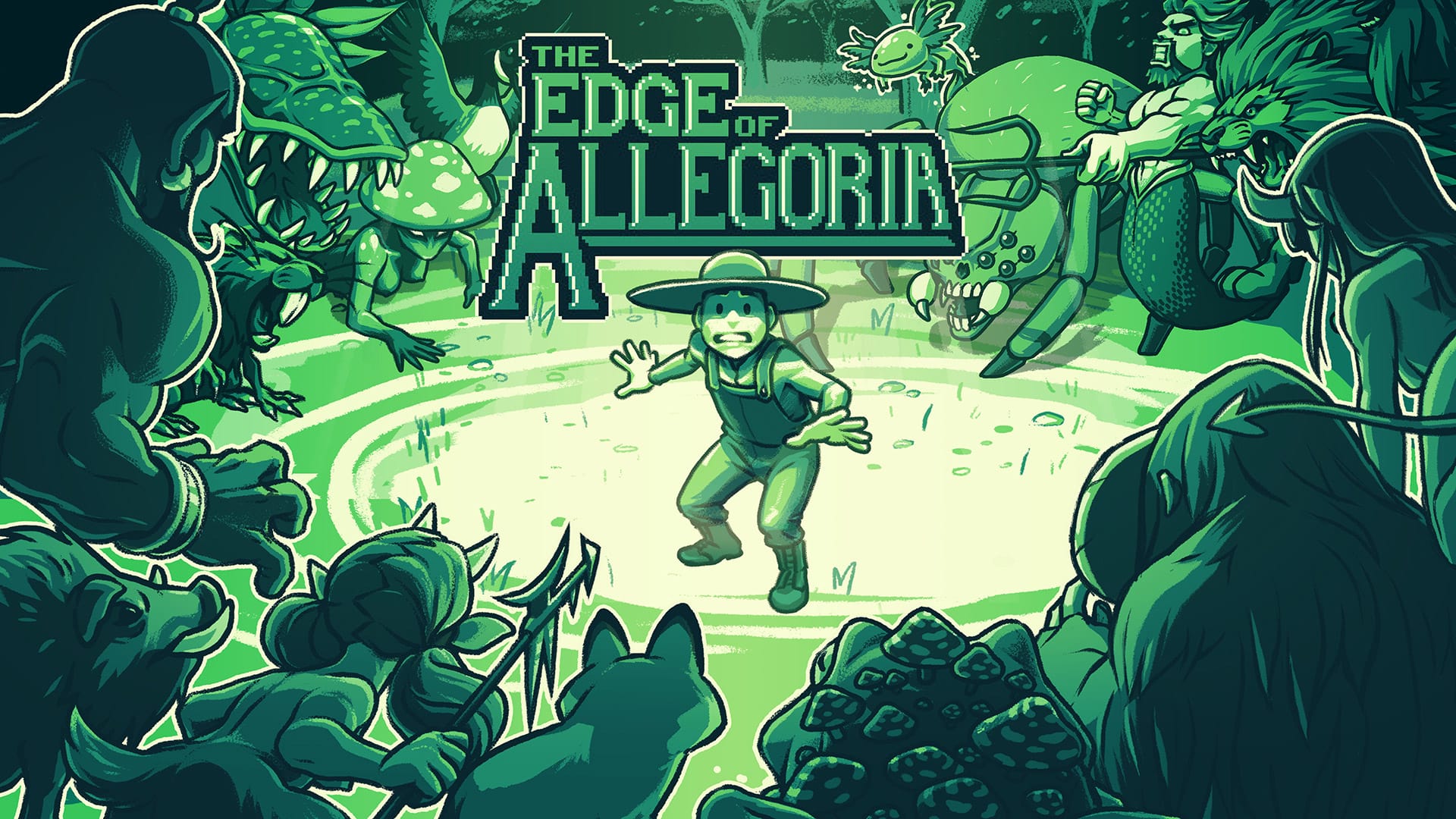
After spending over 3 dozen hours across three separate playthroughs of Edge of Allegoria on Nintendo Switch, countless late nights wrestling with weapon masteries, and more drafts of this review than I care to admit, I can confidently say this game has consumed more of my attention than any indie RPG deserves. The emotional and intellectual journey from initial skepticism to passionate advocacy has been as transformative as the protagonist’s own midlife crisis adventure. What started as casual weekend gaming evolved into an obsessive deep dive into every mechanic, every crude joke, and every nostalgic callback this unhinged masterpiece has to offer.
South Park Meets Pokemon? Easy Pass
When Edge of Allegoria first appeared on my review queue, my reaction was immediate eye-rolling skepticism. Another “retro-inspired” RPG promising to recapture the magic of Game Boy classics while loading itself with juvenile humor and shock value. The promotional materials screamed “edgy for the sake of being edgy,” featuring crude language, sexual innuendo, and what appeared to be South Park-level crassness masquerading as wit. The monochrome aesthetic felt like a lazy shortcut to nostalgia, and the promise of “This ain’t no f@#%ing kid’s game” suggested the developers were confusing profanity with maturity.
My gaming experience spans 15 years of RPGs, from the original Final Fantasy through modern masterpieces like Persona 5 and Divinity: Original Sin 2. I’ve witnessed countless games attempt to shock their way to relevance, mistaking crudeness for creativity and vulgarity for depth. Edge of Allegoria seemed destined to join that forgettable pile of games that prioritize cheap laughs over meaningful gameplay. The developer’s claim of creating a “GameBoy-inspired, turn-based RPG adventure like everything you’ve seen before” felt like an admission of creative bankruptcy wrapped in false nostalgia.
The aesthetic concerns weren’t unfounded. How many pixel art RPGs claim to channel classic handheld gaming while delivering hollow experiences ? The market is saturated with developers who believe adding swear words to Pokemon-style mechanics automatically creates adult entertainment. These factors created legitimate barriers that would understandably deter discerning players seeking substantive gaming experiences rather than crude pastiche.
96 Weapons That Shattered My Cynicism
But Edge of Allegoria accomplishes something remarkable: it transforms initial cynicism into genuine appreciation through sheer mechanical sophistication and surprisingly thoughtful design. Beneath the crude exterior lies one of the most innovative weapon mastery systems in recent memory, creating a gameplay loop that rivals the addictive collection mechanics of the very games it parodies. The moment this clicked for me came during my first boss encounter with a divine being, when I realized the seemingly random weapon drops and mastery percentages formed an intricate puzzle of skill combination and strategic depth.
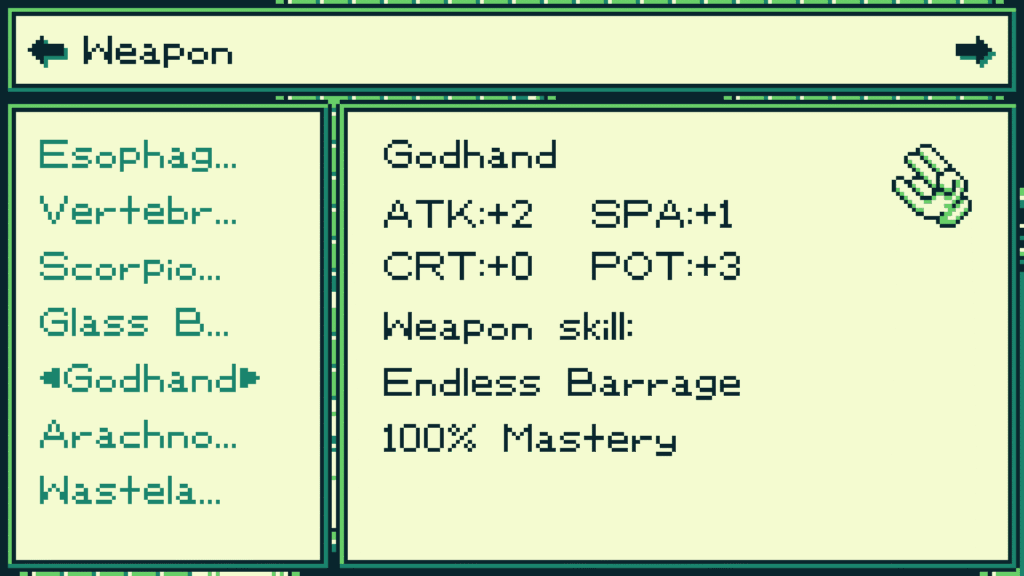
The game’s 96 weapons aren’t just cosmetic variations. Each represents a unique piece of a larger strategic framework. The mastery system permanently absorbs weapon skills into your character, creating endless possibilities for combat customization that puts many AAA RPGs to shame. What initially appeared as mindless grinding revealed itself as purposeful progression, where every battle contributes to expanding your tactical arsenal. This mechanical depth rivals the complexity found in games like Final Fantasy Tactics or Fire Emblem, wrapped in an accessible interface that welcomes newcomers while rewarding veterans.
The narrative structure, while crude on the surface, demonstrates remarkable self-awareness and genuine emotional resonance. The protagonist’s midlife crisis journey through the land of Allegoria serves as both parody and sincere exploration of middle-aged disillusionment. The game successfully balances absurdist humor with moments of unexpected vulnerability, creating a tonal complexity that sophisticated adult audiences can appreciate. The writing acknowledges its own crassness while using it purposefully to examine themes of masculinity, purpose, and personal growth in ways that surprised me with their nuance.
Philosophy Hidden Behind F-Bombs
Edge of Allegoria’s story transcends its crude packaging through surprisingly sophisticated character development and thematic exploration. The unnamed protagonist’s journey from simple man to reluctant hero mirrors real-world anxieties about purpose and relevance in middle age. The game’s willingness to confront uncomfortable truths about masculinity, social expectations, and personal fulfillment creates emotional resonance beneath its irreverent surface. Key narrative moments subvert expectations, particularly during encounters with the six divine beings who each represent different aspects of the human condition.
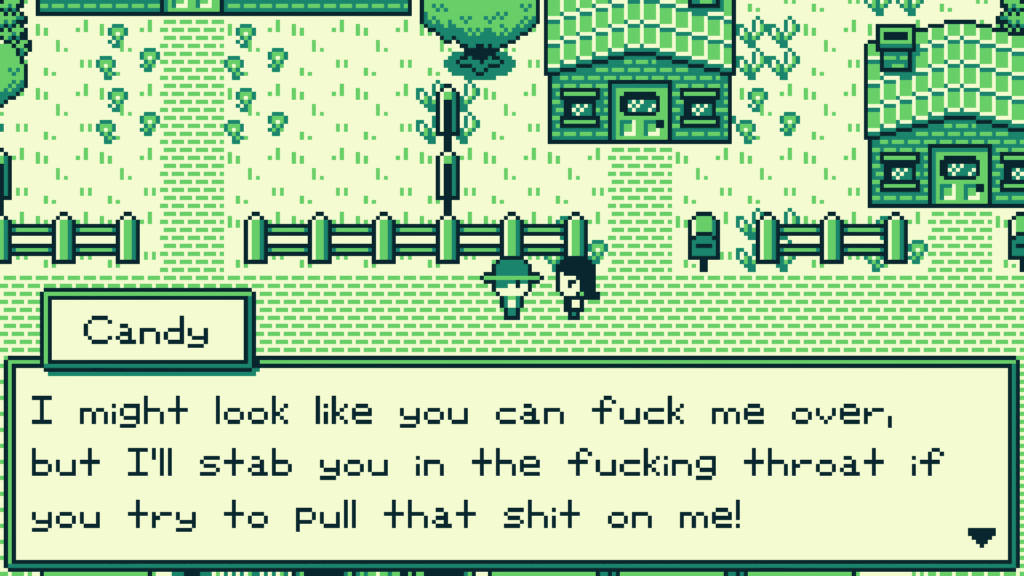
The world-building demonstrates remarkable consistency despite its apparent chaos. Allegoria feels lived-in and authentic, with each town and region reflecting different stages of societal development and moral complexity. The game’s exploration of power structures, religious authority, and personal agency creates philosophical depth that rivals more “serious” RPGs. The crude dialogue often masks genuine insights about communication, relationships, and social dynamics, revealing sophisticated understanding of human nature beneath the profanity.
Character interactions evolve meaningfully throughout the journey, with NPCs displaying growth and complexity that extends beyond their initial crude presentations. The game’s treatment of death, responsibility, and consequence demonstrates genuine emotional intelligence, particularly in how it handles the protagonist’s relationship with his faithful dog companion. These thematic elements create narrative momentum that sustains interest across the game’s substantial 20-hour runtime.
Combat That Puts AAA Games to Shame
The weapon mastery system represents Edge of Allegoria’s greatest achievement, creating strategic depth that emerges naturally from intuitive mechanics. Each weapon contains unique skills that become permanently accessible once mastered through combat use, encouraging experimentation with different fighting styles and tactical approaches. The absence of MP limitations on weapon skills transforms combat from resource management into creative problem-solving, where players can freely combine abilities to create devastating attack sequences.
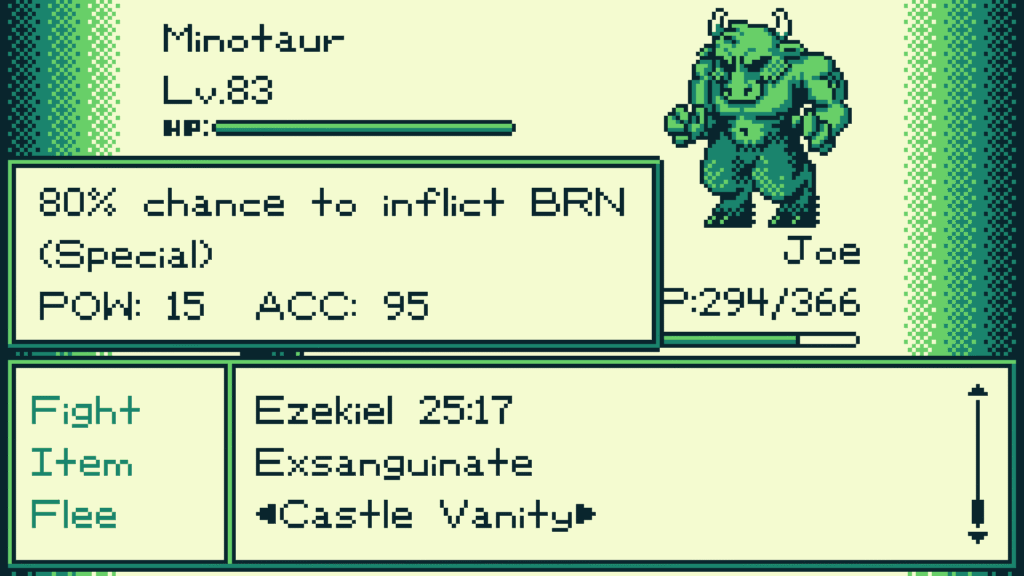
Combat encounters demand strategic thinking beyond typical turn-based RPG conventions. The six status ailments (Poison, Bleed, Burn, Drowsiness, Stiffness, and Madness) create tactical complexity that requires careful planning and adaptation. The infliction system isn’t merely punitive; it becomes a strategic tool players can weaponize against enemies, creating combo opportunities that reward deep mechanical understanding. Boss encounters particularly showcase this depth, with each of the 41 bosses requiring different tactical approaches and weapon combinations.
The game’s progression systems interlock brilliantly, with exploration, combat, and collection reinforcing each other in satisfying ways. The massive world containing 31 dungeons provides meaningful content variety, while the 145 monster types ensure encounters remain engaging throughout extended play sessions. The death penalty system (losing weapon mastery progress while reducing boss levels) creates meaningful consequences without punishing players excessively. This balance between challenge and accessibility demonstrates sophisticated game design that serves both casual and hardcore audiences.
Pixel Perfect: Game Boy Nostalgia Evolved
The monochrome Game Boy aesthetic transcends mere nostalgia to become a genuine artistic statement. Button Factory Games demonstrates masterful pixel art technique, creating visual distinction and personality within severe technical constraints. Enemy designs showcase remarkable creativity and characterization, with each of the 145 monster types displaying unique visual identity and attack animations that enhance their mechanical differences. The boss designs particularly excel, featuring intricate sprite work that rivals the best examples from handheld gaming’s golden age.
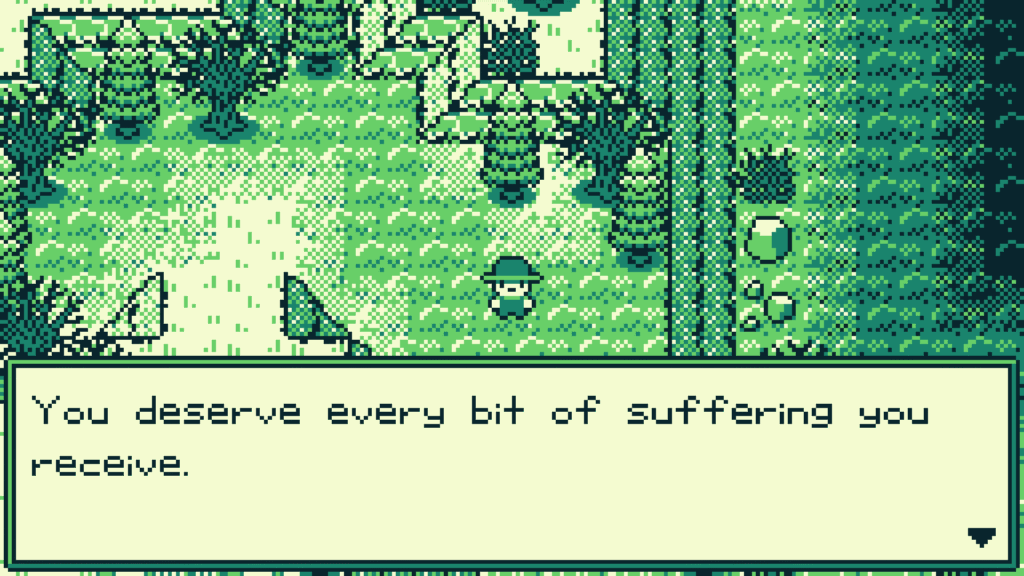
The game’s use of color for status effects creates both functional clarity and aesthetic impact. Bleeding enemies turn red, stiffness creates stony gray tones, and madness produces psychedelic visual distortions that enhance the sensory experience of combat. These design choices serve gameplay clarity while maintaining the overall monochrome aesthetic that defines the game’s visual identity. The cutscenes bookending major story moments feature exceptional pixel art that demonstrates the development team’s artistic ambition and technical skill.
The chiptune soundtrack perfectly complements the visual design, featuring catchy compositions that evoke classic Game Boy and early Final Fantasy music. The dynamic score adaptation based on status ailments adds sophisticated audio feedback that enhances gameplay immersion. Sound design throughout creates authentic retro atmosphere while supporting modern gameplay clarity and feedback systems.
Pokemon for Adults: Finally Done Right
Edge of Allegoria occupies a unique position within the crowded retro RPG revival market by committing fully to its irreverent vision while delivering mechanical substance. Where many Pokemon-inspired games fail by copying surface elements without understanding underlying design principles, Edge of Allegoria deconstructs and rebuilds these mechanics with genuine innovation. The weapon mastery system provides more meaningful progression than many modern RPGs, creating collection incentives that rival the original Pokemon games while serving adult sensibilities.
The game’s crude humor serves a specific purpose rather than existing for shock value alone. Unlike South Park games that rely primarily on reference humor, Edge of Allegoria uses its irreverent tone to explore genuine themes while maintaining consistent world-building and character development. The comparison to Deadpool is apt. Both properties use crude humor to examine deeper psychological and social issues while entertaining audiences who might otherwise dismiss such content.
Within the broader indie RPG landscape, Edge of Allegoria demonstrates that innovation can emerge from familiar frameworks when developers understand their source material deeply enough to meaningfully subvert expectations. The game succeeds where many retro revivals fail by offering genuine mechanical advancement rather than mere aesthetic recreation. Its commitment to mature themes and sophisticated gameplay creates an experience that honors its inspirations while establishing its own creative identity.
Why This Game Consumed All My Time
My relationship with Edge of Allegoria evolved dramatically across multiple playthroughs, revealing new mechanical depths and narrative nuances with each subsequent journey. The initial hours felt overwhelming. Crude humor mixed with complex systems created cognitive dissonance that required adjustment. However, once the weapon mastery concept crystallized, the entire experience transformed into something approaching obsession. Late-night grinding sessions became meditation on the satisfying click of mastery percentages increasing and new skills unlocking.
The game’s emotional resonance surprised me most profoundly during quiet moments between combat encounters. The protagonist’s internal monologue, while crude, often reflects genuine vulnerability and self-doubt that created unexpected identification with his journey. Moments of genuine pathos emerge organically from the irreverent framework, particularly during encounters with divine beings who force confrontation with existential questions about purpose and mortality. These experiences created lasting emotional impact that transcended the game’s crude packaging.
The mechanical satisfaction of discovering effective skill combinations provided genuine joy reminiscent of breakthrough moments in classic RPGs. Successfully chaining bleeding, susceptibility, and damage amplification skills to defeat challenging bosses created euphoric victory moments that justified hours of preparation and experimentation. The game’s respect for player time and effort through meaningful progression systems fostered deep investment in its world and characters.
Four-Hour Battery Life Champion
Edge of Allegoria performs exceptionally well on Nintendo Switch, maintaining consistent framerates throughout extended play sessions. The game’s modest technical requirements translate into reliable performance across handheld and docked modes, with loading times rarely exceeding a few seconds. The pixel art aesthetic scales perfectly to different screen sizes, maintaining visual clarity and artistic integrity whether played on television or Switch Lite.
The user interface demonstrates thoughtful adaptation to Switch controls, with intuitive menu navigation and comfortable button mapping that never interferes with gameplay flow. Combat animations remain fluid and responsive, while the extensive item and weapon management systems benefit from clear organization and quick access options. The game’s save system provides multiple slots and frequent checkpoints that respect player time investment.
Battery life during handheld play extends comfortably beyond four hours, making Edge of Allegoria ideal for extended portable gaming sessions. The game’s optimization demonstrates Button Factory Games’ understanding of Switch hardware limitations while maximizing visual and audio impact within those constraints. Technical polish throughout creates seamless gameplay experiences that never detract from mechanical or narrative engagement.
25 Bucks for 25 Hours of Excellence
At $24.99, Edge of Allegoria delivers exceptional value for money through substantial content and meaningful replayability. The 18-25 hour main campaign provides dense gameplay experiences with minimal padding or artificial content extension. The weapon mastery system encourages multiple playthroughs with different tactical approaches, while hidden secrets and optional bosses reward thorough exploration. Post-completion content includes New Game Plus options that maintain progression satisfaction while introducing fresh challenges.
The game’s mechanical depth supports extended engagement well beyond the initial completion. Completionist players will find 20-30 hours of content pursuing every weapon mastery and boss encounter, while casual players can experience the core narrative satisfaction within reasonable time commitments. The absence of microtransactions or artificial monetization schemes creates honest value proposition that respects player investment.
Compared to similar indie RPGs at comparable price points, Edge of Allegoria provides superior mechanical complexity and narrative ambition. The game’s unique tone and innovative systems justify its existence within the crowded retro RPG market while delivering experiences unavailable elsewhere. Long-term replay value through mastery system experimentation and speedrunning potential extends the value proposition for dedicated players.
The Indie RPG That Shouldn’t Be Missed
Edge of Allegoria transcends its crude exterior to deliver one of the most mechanically sophisticated and emotionally resonant RPGs in recent memory. The game demonstrates that innovation can emerge from familiar frameworks when developers possess deep understanding of their source material and genuine creative vision. Button Factory Games has created something special: a game that honors its inspirations while establishing unique creative identity through bold tonal choices and mechanical innovation.
The weapon mastery system alone justifies the game’s existence, providing progression satisfaction that rivals the best examples in the genre. The narrative complexity beneath the crude humor creates emotional resonance that lingers long after completion, while the technical excellence ensures smooth gameplay experiences throughout extended sessions. Edge of Allegoria succeeds because it commits fully to its vision rather than hedging bets or apologizing for its provocative content.
Pros:
- Innovative weapon mastery system with exceptional depth
- Sophisticated pixel art and authentic Game Boy aesthetic
- Surprising narrative complexity beneath crude humor
- Excellent value with 18-25 hours of dense content
- Perfect Switch optimization and performance
Cons:
- Crude humor will alienate some players
- Initial learning curve can feel overwhelming
- Limited character customization beyond weapon skills
- Some technical mechanics could use better explanation
Final Score: 4.7/5
This is essential gaming for anyone seeking mechanical innovation wrapped in irreverent packaging. Edge of Allegoria proves that mature gaming can emerge from unexpected sources when developers possess both technical skill and creative courage. Don’t let initial impressions prevent you from experiencing one of indie gaming’s most surprising and satisfying achievements.
This review of Edge of Allegoria is based on the Nintendo Switch version, with a code provided by the game’s publishers.

